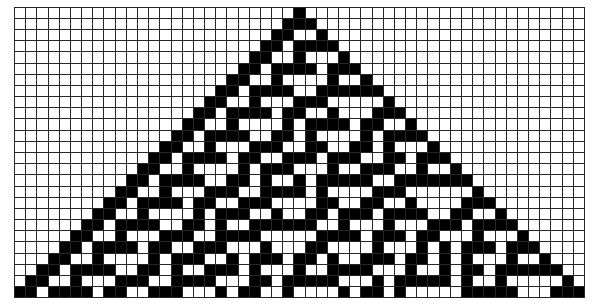Since ancient times, humans have attempted to create models to explain the world. These explanations were stories, mythologies, religions, philosophies, metaphysics, and various scientific theories. Then, about three centuries ago, scientists revolutionized our understanding with a simple but powerful idea: applying mathematical models to make sense of our world. Ever since, mathematical models have come to dominate our approach to knowledge, and scientists have utilized complex equations as viable explanations of reality.
Stephen Wolfram’s A New Kind of Science (NKS) suggests a new way of modelling worldly phenomena. Wolfram postulates that elaborate mathematical models aren’t the only representations of the mechanisms governing the universe; simple patterns may be behind some of the most complex phenomena. In order to illustrate this, he began with cellular automata.
A cellular automaton is a set of colored blocks in a grid that is created stage by stage. The color of each block is determined by a set of simple rules that considers the colors of blocks in a preceding stage.1 Based on just this, cellular automata seem to be fairly simple, but Wolfram illustrated their complexity in rule 30. This cellular automaton, although it follows the simple rule illustrated in Figure 1, produces a pattern that too irregular and complex for even the most sophisticated mathematical and statistical analysis. However, by applying NKS fundamentals, simple rules and permutations of the building blocks pictured can be developed to produce these extremely complex structures or models.2
By studying several cellular automata systems, Wolfram presents two important ideas: complexity can result from simple rules and complex rules do not always produce complex patterns.2
The first point is illustrated by a computer; relying on Boolean logic, the manipulation of combinations of “truths” (1’s) and “falses” (0’s), computers can perform complex computations. And with proper extensions, they can display images, play music, or even simulate entire worlds in video games. The resulting intuition, that complexity results from complexity, is not necessarily true. Wolfram shows again and again that simple rules produce immense randomness and complexity.
There are other natural phenomena that support this theory. The patterns on mollusk shells reflect the patterns generated by cellular automata, suggesting that the shells follow similar simple rules during pattern creation.2 Perhaps other biological complexities are also results of simple rules. Efforts are being made to understand the fundamental theory of physics based on ideas presented in the NKS and Wolfram’s idea might even apply to philosophy. If simple rules can create seemingly irregular complexity, the simple neuronal impulses in the brain might also cause irregular complexities, and this is what we perceive as free will.2
The most brilliant aspect of NKS lies in its underlying premises: a model for reality is not reality itself but only a model, so there can be several different, accurate representations. Our current approach to reality -- using mathematical models to explain the world -- does not have to be the only one. Math can explain the world, but NKS shows that simple rules can also do so. There may be methods and theories that have been overlooked or remain undiscovered that can model our world in better ways.
References
- Weisstein, E. W. Cellular Automaton. Wolfram MathWorld, http://mathworld.wolfram.com/cellularautomaton.html (accessed Mar 26, 2016).
- Wolfram, S. A New Kind of Science; Wolfram Media: Champaign, IL, 2002

